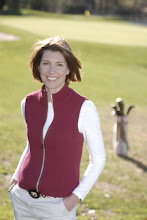Book #5 Bob Toski
Bob Toski's Complete Guide to Better Golf (c 1977)
I chose this book because I didn't know much about Toski and have always been told by peers "oh you have to read some of his stuff, its really good.." So I ordered this 1983 copy off Amazon.com because I couldn't find it in the store. This was definitely a piece of nostalgia...should I read it, or frame it? !
So this was originally published a few years before I was born... which means almost 15 years before I even picked up a golf club or ever read a golf instruction book. The whole time I was reading this book (illustrated/photographed in full color by the way:) as it states on the cover!) I had to laugh at a few things like "turn your cheek at address.." and "Reverse C for a swing that's free".... not exactly what you would hear now a days... also, "distance formula: add motion, subtract muscle". From what I understand that (the latter point) sums up Toski's teachings. The "60's- 70's" swing" like many things in those decades was more free. In golf terms: whippy, handsy and more about timing. Today timing is important but with all the research in bio-dynamics and popularity of fitness, there is much more muscle and much less hands in golf now.
In the book, Johnny Miller's grip was not criticized for being weak nor was Lee Trevino for being very strong, but the differences were recognized as style preferences. Toski (with Dick Aultman, Golf Digest) nicely illustrate the why and how of ball-flight patterns. In this faults and fixes section many times, Toski suggests slowing down a backswing or lengthening a backswing as a way to fix a problem. You would very rarely here this fix today when talking about how to fix topping or pulling.
I kept thinking.. okay, what is so special about this book? What made Bob Toski so renowned? I guess because I didn't live through it, its hard for me to understand what may have been earth shattering about this book at the time. Was it just a quintessential book of its time, laying out points of swing style and theory? Or was there some NEW idea that he presents that I just don't recognize since I didn't live through it? Maybe everything in this book was "new" at the time and I just don't realize it? Maybe someone out there can help?
One last note.. I did enjoy, for nostalgia sake, the 30+ pages at the end of the book with Toski's detailed analysis of various swing sequences from popular golfers at the time. That was kinda of neat to compare in my own mind how different the swings of today look.
So my personal takeaway on Toski is this: the average golfer is typically not in supreme physical condition, so a knee sliding, handsy approach to the swing could work in his/her favor and allow for decent speed to be created. However... the average golfer is looking for consistency and hands and timing are two of the hardest things to control from a consistency standpoint. It puts more importance on the coordination of the small muscles amount of practice it would take to train them to repeat a particular pattern in a particular timing to work. So therefore, the more modern swing driven by positions and patterns of the big muscles is simpler and easier to be consistent with for the average golfer.. in my opinion.
But of course its your choice...Hands or muscle... which kind of golfer are you?
Thanks for the perspective Mr. Toski. Its always refreshing to look back.


0 Comments:
Post a Comment
Subscribe to Post Comments [Atom]
<< Home